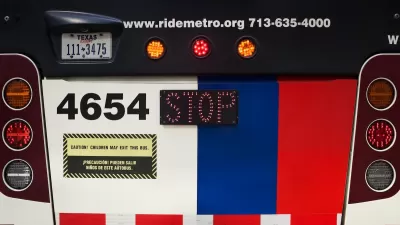On-demand transit is helping make transportation around the resort area more convenient, but the region still lacks connectivity via a fixed-route bus system.

Two free, on-demand microtransit services in Lake Tahoe are becoming a big hit with locals and visitors, reports Julie Brown Davis in SF Gate.
Local officials hope the services will help reduce traffic congestion in the increasingly popular mountain town and improve the lake’s water clarity. TART Connect, the service in Tahoe’s north shore and Truckee, hit one million rides this spring.
However, Davis points out that “Right now, there’s no public transportation between Lake Tahoe’s north shore and its south shore — not even on the microtransit shuttles, which are confined to their respective zones on either side of the lake.”
Without a more robust fixed-route bus system, Tahoe will likely continue to suffer traffic woes. “Microtransit is best designed for short trips, buzzing people around to the ski resorts, the casinos, the beach or the trailhead. It’s meant to get people to and from the last mile of their journey, syncing with a larger transit system that includes fixed bus routes.”
FULL STORY: ‘Demand is almost endless’: These Tahoe shuttles are giving out free rides

Trump Administration Could Effectively End Housing Voucher Program
Federal officials are eyeing major cuts to the Section 8 program that helps millions of low-income households pay rent.

Planetizen Federal Action Tracker
A weekly monitor of how Trump’s orders and actions are impacting planners and planning in America.

Ken Jennings Launches Transit Web Series
The Jeopardy champ wants you to ride public transit.

Tackling Soil Contamination With Nature-Based Solutions
Los Angeles County residents and experts are turning to nature-based methods like bioremediation to address long-standing and fire-exacerbated soil contamination without resorting to costly and disruptive removal.

Rebuilding Smarter: How LA County Is Guiding Fire-Ravaged Communities Toward Resilience
Los Angeles County is leading a coordinated effort to help fire-impacted communities rebuild with resilience by providing recovery resources, promoting fire-wise design, and aligning reconstruction with broader sustainability and climate goals.

When Borders Blur: Regional Collaboration in Action
As regional challenges outgrow city boundaries, “When Borders Blur” explores how cross-jurisdictional collaboration can drive smarter, more resilient urban planning, sharing real-world lessons from thriving partnerships across North America.
Urban Design for Planners 1: Software Tools
This six-course series explores essential urban design concepts using open source software and equips planners with the tools they need to participate fully in the urban design process.
Planning for Universal Design
Learn the tools for implementing Universal Design in planning regulations.
Ada County Highway District
Clanton & Associates, Inc.
Jessamine County Fiscal Court
Institute for Housing and Urban Development Studies (IHS)
City of Grandview
Harvard GSD Executive Education
Toledo-Lucas County Plan Commissions
Salt Lake City
NYU Wagner Graduate School of Public Service





























